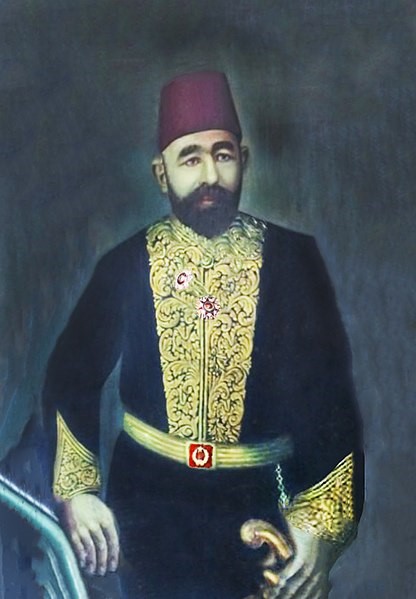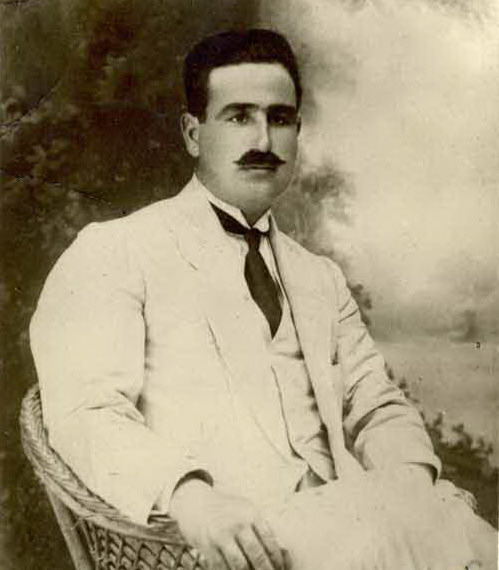Nawras Pasha, the Naqib al-Ashraaf of Ma’arrah in the hujjah of *Werdi
*Werdi was one of the mares imported by Homer Davenport to the USA in 1906. Her hujjah (certificate of authenticity) is particular among the hujaj of the Davenport imports in that its front side is for a bay mare that is *Werdi’s close relative, most probably her sister, but not *Werdi herself.
The hujjah belongs to a bay or dark brown mare without markings, purchased by a man from Aleppo. This bay mare’s sire is a Ma’naqi Sbayli, the horse of “Nawras Effendi the Naqib of Ma’arrah which is a dependency of the vilayet of Aleppo“. Her dam is the “grey mare of Faris Agha al-Turkmani of the people of Hamah“. The bay/brown mare is a Kuhaylah Krush to be mated.
I did a little bit of research on Nawras Effendi. He turned out to be a prominent man in the town of Ma’arrah. Perhaps he was the most prominent person in the city. Ma’arrah is a large, ancient, historical town south-west of Aleppo. It suffered a lot in the Syrian civil war.
The “Naqib”, short for “Naqib al-Ashraaf”, is the head of the congregation of the descendants of the Prophet Muhammad, the Ashraaf (in the plural, the singular is Sharif). There was one for each large city, since the time of the Mamluks then the Ottomans: Cairo had its Naqib al-Ashraaf, and so did Aleppo, Damascus, Jerusalem, Basra, Bagdad, Mossul, etc. Smaller cities like Homs and Maarrah also had their Naqib al-Ashraaf.
The position typically alternated between two or three prominent Sharif families in every city. It was a post of high social and religious significance, and the family that held it oftenwielded economic and political power as well. The Wikipedia article on Naqib al-Ashraaf is informative and provides good background.
In Ma’arrah, the position of Naqib al-Ashraaf was held by the al-Hiraaki al-Husayni family. Al-Husayni is a reference to a direct descendance from Husayn, the maternal grandson of the Prophet Muhammad. Another branch of the same family held the position of Naqib al-Ashraaf in the neighboring city of Hims/Homs.
In the late XIXth and early XXth centuries, the Naqib al-Ashraaf for Ma’arrah was Nawras Pasha al-Hiraaki al-Husayni (the man in the painting below, and in the photo below, where he is the second from the right). He is indeed the one mentioned in *Werdi’s hujjah. He was a powerful man. He sent his children to be educated in Istanbul, as did other Syrian aristocrats and grand bourgeois of the time.


His son Sami al-Hiraaki become governor of Ma’arrah under the short-lived reign of King Feisal I in 1919. His second son Hikmat al-Hiraaki (1886-1969, photo below), became member of parliament for Ma’arrah, then Minister in the new Syrian Republic. He was one of the fathers of the first Syrian Constitution.

Families of Naqib al-Ashraaf made it a point of pride and religious observance to maintain only the purest Arab horses. This speaks very well for the origin of the Ma’naqi Sbayli stallion of Nawras Pasha/Effendi in the hujjah of *Werdi. The high social status of the Ashraaf also meant that they had access to the best horses of the nearby Bedouin. The summer encampments of the Sba’ah Bedouin, who owned the precious strain of Ma’naqi Sbayli, were right on the outskirsts of the city of Ma’arrah.
*Werdi is mentioned as an addendum in the back of the hujjah, a chestnut mare with a blaze and a stocking that is “the […] of the grey mare mentioned in the front.” No sire is given. The key word (daughter, sister) that characterizes the relationship with the grey mare is missing here.
The grey mare is not the main protagonist in the front of the hujjah, but her bay daughter is. Since a hujjah typically identifies a mare by her sire and her dam (rather than by her sister), one can safely assume that the missing word about *Werdi is “[daughter] of the grey mare mentioned in the front“. That would make *Werdi the maternal sister of the bay mare.
Unless the bay mare and *Werdi are full sisters, we do not know if the Ma’naqi Sbayli of Nawras Pasha/Effendi, sire of the bay mare, is in the pedigree of *Werdi. Still, I keep being surprised by how closely the Davenport imports were associated with the Syrian elite of the time.
Hello,
I stumbled on this article and website by searching my family name in an attempt to find an article about one of my great-grandfathers. I am a direct descendant of Nawras Pasha and Hikmat Al Hiraki. I shared your blog to many of my family members and we all enjoyed reading this article.
I would love to discuss your findings further and, if possible, see pictures of the documentations you discovered.
Thank you,
Mudar Al Hraki
This is great news Mudar. I look forward to exchanging with you and your family.